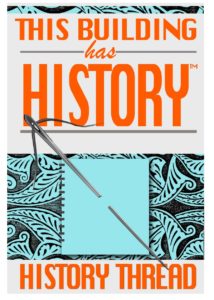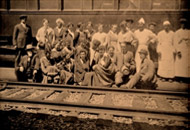The Rock Hill Herald reported on May 12, 1916 – “Directors of the Parker Cotton Mill Company meeting in Greenville voted to sell the eight mills in their Hampton Group to Lockwood Green and Co., of NY for just under $3,000,000. The mills include Granby, Richland, Olympia, and Capital City in Columbia; Beaver Dam in Edgefield, Fairfield in Winnsboro, Wylie in Chester and Pine Creek in Camden. The creditors of the Parker Cotton Mills will receive 70% of the debts in cash and the balance in preferred stock.”
City Directories and History: Olympia Mill stands as an intact example of late nineteenth century textile mill architecture. Constructed in 1899, the building is significant architecturally as an important example of the Romanesque Revival style applied to industrial architecture and as the work of important mill designers W.B. Smith Whaley & Company. William Burroughs Smith Whaley designed, owned and operated Olympia Mill, serving as its first president. Olympia was one of four cotton mills the firm designed and constructed in

Image of the mill courtesy of photographer Ann L. Helms – 2018
Columbia. The firm’s innovations in mill design contributed to the rise of the textile industry in South Carolina and helped to secure their position as one of the most important textile mill designers in the nation. When Olympia Mill opened in 1899, it was widely recognized as “the largest cotton mill under one roof in the world.” The mill is comprised of a massive four-story, red brick, rectangular shaped, main mill building that is connected to an original one and two-story red brick power plant. Other buildings that are part of the mill complex include: a one-story brick power plant auxiliary building, a one-story storage building, and two small brick one-story gate houses. Surrounding the site is the historically related Granby Mill to the west and the Olympia Mill housing village to the east and south. The main building contains features of the Romanesque Revival style with a red brick exterior embellished with terra cotta detailing, large segmental arched window openings, and twin pyramidal roofed towers that rise above the flat roofline. Listed in the National Register February 2, 2005. (Courtesy of South Carolina Department of Archives and History)
*** See PDF this page on the New South Textile Industry. Also see link this page to Thomas M. Bomar, an African American contractor from Spartanburg who built many of Whaley’s S.C. mills. However, there are no documents on his working on the Olympic Mill itself.

The Columbia Canal provided power to many of the mills on the banks of the Saluda River. Image courtesy of the AFLLC Collection – 2017
Stay Connected
Explore history, houses, and stories across S.C. Your membership provides you with updates on regional topics, information on historic research, preservation, and monthly feature articles. But remember R&R wants to hear from you and assist in preserving your own family genealogy and memorabilia.
Visit the Southern Queries – Forum to receive assistance in answering questions, discuss genealogy, and enjoy exploring preservation topics with other members. Also listed are several history and genealogical researchers for hire.
User comments welcome — post at the bottom of this page.

R&R HISTORY LINK: Thomas M. Bomar, African-American contractor and mason who worked closely with W.B. Smith Whaley….
Please enjoy this structure and all those listed in Roots and Recall. But remember each is private property. So view them from a distance or from a public area such as the sidewalk or public road.
Do you have information to share and preserve? Family, school, church, or other older photos and stories are welcome. Send them digitally through the “Share Your Story” link, so they too might be posted on Roots and Recall.
Thanks!



